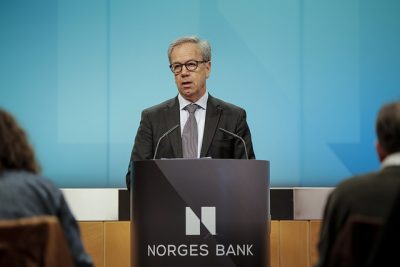The head of Norway’s central bank, Øystein Olsen, and the man running the central bank’s unit in charge of managing Norway’s huge Oil Fund, Yngve Slyngstad, disagree on the fund’s future. Their disagreement has now been branded as a “power struggle” that can only be settled by the state politicians ultimately responsible for the fund, as a major source of pension income in the years ahead.

Newspaper Dagens Næringsliv (DN) reports that Olsen and Slyngstad are “on a collision course.” At issue is whether the Oil Fund should continue to be managed by a subsidiary of the central bank (Norges Bank Investment Management, NBIM), or spun off into a separate state-owned company independent of Norges Bank that reports directly to the Finance Ministry. That could allow more “active management” of the huge fund independent of concerns over Norwegian monetary policy, and also involve higher management risk.
A government commission set up to study the issue supports the latter alternative. The commission, headed by Olsen’s predecessor as Norges Bank’s governor, Svein Gjedrem, has basically recommended a divorce between the central bank and NBIM. The Gjedrem Commission believes that fund management presents entirely different demands for competence than those found within traditional central bank operations. It’s not easy, reasons the commission, to find people who are both experts at financial management and monetary policy.
Now it’s emerged that Slyngstad, who has headed NBIM since taking over for its founding chief executive Knut Kjær nearly 10 years ago, agrees with the commission. DN reported just before the weekend that Slyngstad wants to move the fund’s management out of the central bank, and he reportedly argued in favour of such a move during a bank board meeting earlier this month. The board of Norges Bank also functions as the board of NBIM.

Olsen, who’s effectively Slyngstad’s boss, does not want the Oil Fund to leave the central bank, which he claims has “been a good home” for it since it was first set up in 1996. The Oil Fund was established as a means of stashing away Norway’s ever-growing oil revenues at the time for future generations. Most all of the money pumped into state coffers from Norway’s offshore oil industry is deposited into the fund, which in turn is invested mostly in stock markets abroad and, more recently, high-end real estate in cities like London and Paris. Under current regulations, only 3 percent of the fund’s total market value can be used to pad the state budget every year.
The fund has grown rapidly, far beyond the wildest expectations of Norwegian officials, and into one of the world’s largest sovereign wealth funds. Some argue it’s simply outgrown the central bank, and could thrive even more outside the bank’s purview.
Others firmly disagree. Arne John Isachsen, a professor at the Norwegian Business School BI, opposes moving the fund’s management out of the central bank precisely because it has “another culture” than the central bank. He raises issues of loyalty if the Oil Fund’s management is given too much independence. By having its “home” in the central bank, Isachsen wrote in newspaper Aftenposten on Monday, “the culture of financial acrobats is held under the thumb of Norges Bank. If the Oil Fund is placed in its own company, like the Gjedrem Commission wants, the risk of more acrobatics will rise.”

DN also editorialized on Monday that the Gjedrem Commission downplayed the danger of higher risks tied to moving the fund out of the central bank, both in terms of financial losses on riskier investments and in “weakened legitimacy” in the eyes of the Norwegian public the fund is meant to serve. That danger “should definitely not be downplayed by the politicians” who must act on the commission’s recommendations. “Building up a fortune (as Norway has, through its Oil Fund) takes, as a rule, longer time than playing it away,” DN wrote.
It’s unclear whether the board of both Norges Bank and NBIM will make any clear recommendation to the Finance Ministry and the rest of Norway’s government itself. Not only does it face disagreement between the two men running the central bank and the Oil Fund, board members are reportedly split on the issue themselves. Ultimate responsibility for Norway’s oil wealth lies with the government and Parliament.
When a round of hearings on the Gjedrem Commission’s proposal wraps up this fall, Finance Minister Siv Jensen of the conservative Progress Party and her colleagues will need to evaluate the issues surrounding organization of the Oil Fund and then formulate a government proposal to Parliament.
newsinenglish.no/Nina Berglund

